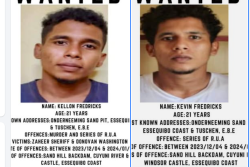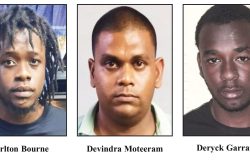Dear Editor,
The news article ‘Third term case for CCJ’ (SN, February 23), may be the only ray of hope for Guyanese who lived through the Forbes Burnham and Bharrat Jagdeo eras and understand what it means to endure presidencies fraught with dictatorial propensities.
In fact, it was precisely to prevent future presidents of Guyana from exhibiting dictatorial behaviours after being in office for too long that the Constitutional Reform Committee explored the idea of instituting presidential term limits. The concept was based on the two-term limit in effect in the United States since March 21, 1947, which wasn’t a standalone law as much as a constitutional amendment with the primary objective of preventing presidents from becoming de facto monarchs.
Editor, Guyana experienced four national elections for the presidency – 2001, 2006, 2011 and 2015 – and not once did we see a petition drive by political parties for a referendum to overturn the presidential term limit constitutional amendment in Guyana. Not even the PPP, which enjoyed a parliamentary majority from 1992 to 2011, ever pushed for an overturning of the law.
It was not until after the PPP lost its parliamentary majority for the first time in 2011 and the writing was on the wall that the days were over for the PPP winning elections outright based on numerical majority support from Indian Guyanese that someone, somewhere, began to surreptitiously seek ways to overturn the presidential term limit law.
In fact, two years before Jagdeo demitted office in 2011, there was a concerted effort by several persons, including the late Reepu Daman Persaud, to push for a Jagdeo third term. There were even billboards and handbills with his name and face as part of the promotion, but the push did not sit well with Donald Ramotar who felt it was his turn to become President.
According to Stabroek News, ‘Reepu’s third term call does not reflect PPP position -Ramotar,’ (October 26, 2009). Mr Ramotar actually said, “…the PPP remains with the Constitution. What Mr Persaud said reflected his personal views on the issue and not the party’s position.”
Mr Ramotar would eventually become the President of Guyana in 2011 with a minority government, but in December 2014, Georgetown resident, Cedric Richardson, filed a writ in the Guyana High Court challenging the two term limit and the manner in which the constitution was amended. When the writ was filed Mr Jagdeo had denied any involvement and said he was not interested in being elected to a third term in office.
Richardson was, hitherto, a virtual unknown political and legal quantity in Guyana, and his court move raised suspicion among Guyanese at home and abroad that he was being used as a conduit to help Bharrat Jagdeo make a political comeback. The legal aspect of the Jagdeo comeback gained traction when former Chief Justice Ian Chang ruled on July 9, 2015, that the 2000 amendment that produced the presidential term limit was unconstitutional. The coalition government appealed, and on February 22, 2017, acting Chancellor Carl Singh and Justice B S Roy upheld Chang’s ruling, while acting Chief Justice Y Cummings-Edwards, ruled against it. The legal aspect of the comeback gained greater traction, even as moves were already being made to secure Mr Jagdeo’s political position.
Even if one were to foolishly suspend disbelief about a Jagdeo comeback, even after repeatedly stating he had no further interest in public office or even a third presidential term, Mr Jagdeo literally engineered his comeback bid. Remember August 2013 when Mr Ramotar strangely ceded leadership of the PPP to Clement Rohee under the guise of wanting to focus more on government work? Well, after the PPP lost in 2015, Mr Ramotar was no longer PPP Leader and so he was easily ousted from becoming the new Opposition Leader, which went to Mr Jagdeo. This was later followed by Mr Jagdeo taking the PPP leadership from Mr Rohee at party elections in January this year.
As the new Opposition Leader, the pieces of the Jagdeo jigsaw puzzle keep falling into place. One can now understand why the appellate court ruling on Wednesday, February 22, was more than just about people having the right to decide, via a referendum, on presidential term limits. The people voted four times for President since 2000 and never protested the term limit law. One inconspicuous citizen was all it took, but these various moves, dating back to 2009, are now considered parts of the sum total of a political comeback bid.
I hope that, as this case moves to the Caribbean Court of Justice, Guyanese pay close and careful attention to Bharrat Jagdeo. Not even sugar workers, who form the backbone of the PPP support base, can take comfort in the knowledge that this comeback kid, who failed them for 12 years, deserves another term.
Yours faithfully,
Emile Mervin








